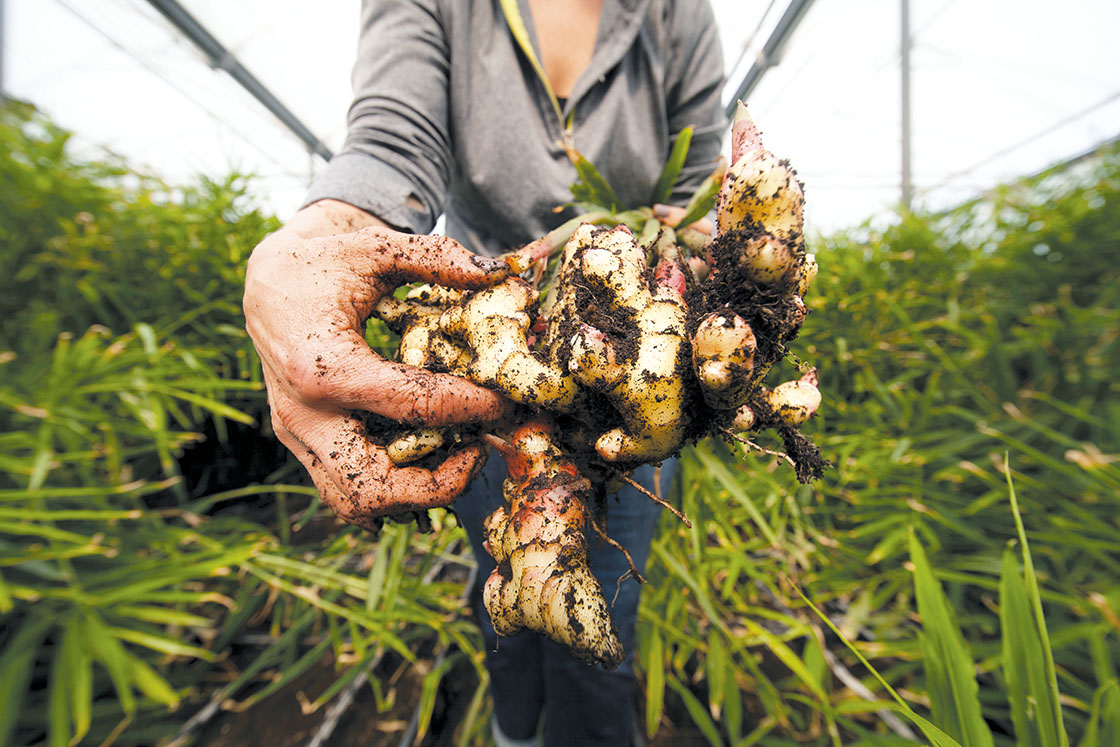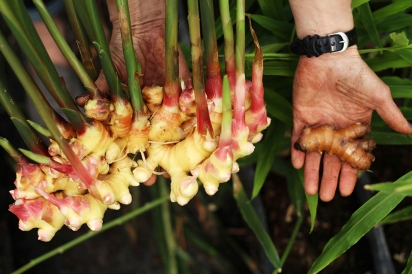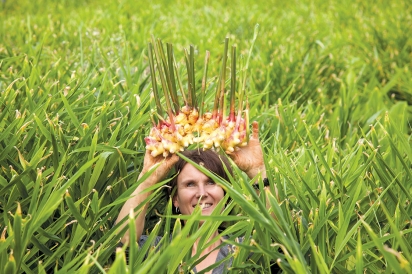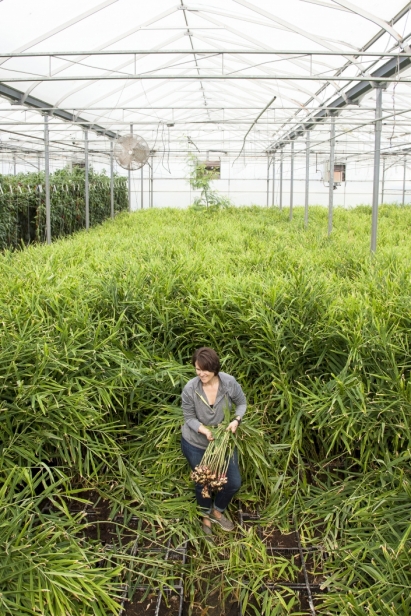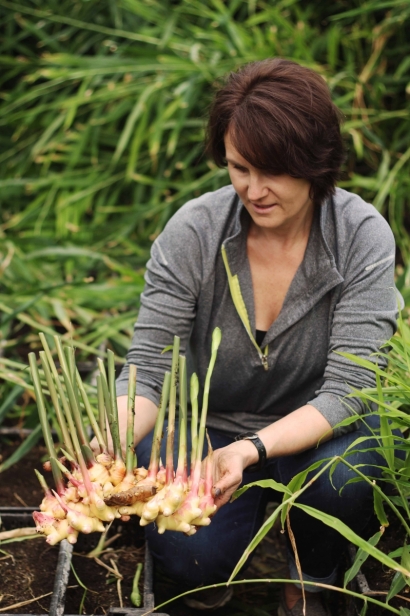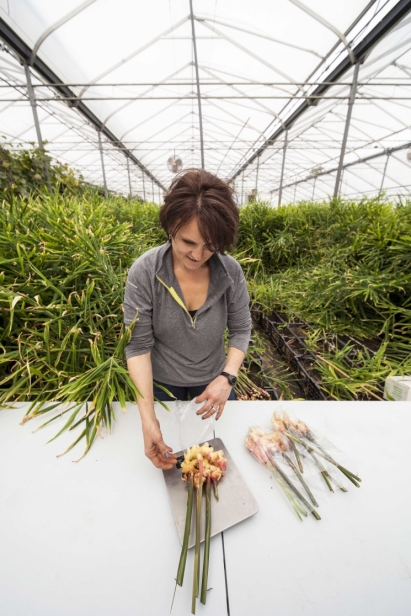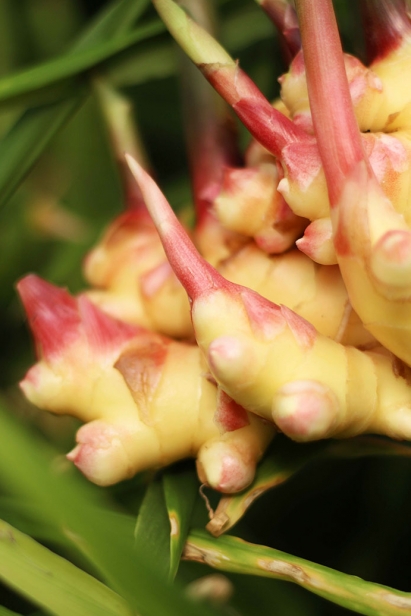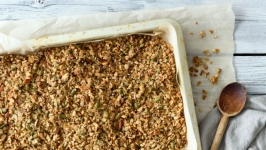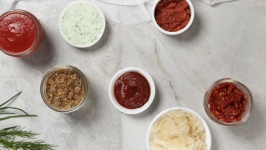Fresh Ginger, Baby
Driving past Fisherville Greenhouses just 20 minutes south of Hamilton, one would probably never guess what luscious tropical-looking plants are inside waiting to be harvested.
The unlikely crop? Ginger.
Unlikely because there aren’t very many places in Canada, or North America for that matter, that grow ginger. But it’s become quite a passion for life-long farmer Cindy Mueller, one she hopes to root herself in permanently.
“About four years ago, we started growing some ginger because we use it in our own lives,” Mueller says. She and her husband, Ron, grew up on family farms and quickly realized after graduating from university that they wanted to own and run their own business. They purchased their Fisherville farm in 2006 and started growing tomatoes. In 2010, they expanded with more vegetables before branching out into ginger and turmeric.
After a few seasons of trial and error, Mueller is ready with their latest ginger crop. She is confident this is the best batch yet.
Aside from the rarity of accessing local ginger in Canada, there’s something else that makes this ginger unique.
“It’s a product not too many people know about,” boasts Mueller, who holds a background in horticulture from the University of Guelph. “It’s not the brown ginger you see in the grocery stores. It’s a young version of that.”
Depending on the stage of the root, it can be known as young ginger, baby pink ginger, fresh ginger and spring ginger.
The brown root, a common ingredient in Asian and Caribbean dishes, is what we are used to purchasing at the grocery store. It’s usually tropically grown, and that’s why it’s seldom cultivated in these parts of the world. That store-procured ginger is a 12- to 18-month crop, while Mueller’s ginger is a six- to seven-month crop.
To grow it, Cindy and Ron order the seed pieces, which look like the more common brown root, and place them in the greenhouse with heat until they show buds. New seed must be ordered yearly, to reduce the possibility of disease, she says.
From there, they plant it in a compost-cocoa-fibre mix in late February. In her greenhouse, the crop remains on a drip system and gets watered on a regular basis. She says it takes about a month before the ginger pops through the soil. In August, the harvest begins.
To harvest the ginger, they pull it out of the soil mix with two or three inches of the stock on the plant. Mueller describes it as a low-maintenance crop, until harvest, when they must pick it by hand, then hand-wash and hand pack it.
Oddly enough, the version Mueller grows is more tropical in appearance than fully mature ginger that acutally comes from the tropics.
The creamy white hue of the fresh ginger is met with a bright pink blush, beautifully contrasted with the green plant at harvest time. It also has some other slightly different properties than its older counterpart.
The root has the same shape as traditional ginger, but a milder flavour. There’s still enough bite to remind you that it’s ginger, but it won’t leave your mouth on fire. It’s juicier, and the texture is different, too. Mueller likens the brown ginger to cutting into a burlap bag, and fresh ginger more to slicing into garlic. It also doesn’t need to be peeled. That texture and lighter flavour lends itself nicely to stir fries, grating into baked goods, or heating up in some hot water for a cosy and all-natural tea when you’re feeling under the weather.
And speaking of health, the benefits of young versus old ginger remain the same. Ginger has been used for thousands of years for medicinal purposes, specifically to reduce nausea and inflammation.
There have been medical studies showing ginger has helped reduce stomach aches during pregnancy and chemotherapyinduced nausea. It’s an ingredient in several flu-aiding teas, and has been candied for those who want tummy relief on the go.
As the world’s interest in healthy living grows, Mueller hopes her ginger business, The Canadian Ginger Company, grows too.
For now, curiosity abounds. She and her husband attended the Caledonia Winter Fair in September and offered attendees a cup of ginger tea. They also attended the Royal Winter Fair in November and provided their product to chefs at the Burnbrae Farms Culinary Academy.
“A lot of people coming through said ‘ginger is supposed to be really good for you,’” Mueller says. “I think in light of everyone trying to get healthy, it’s becoming more popular, the health benefits are becoming more known.”
The movement towards healthy eating is a very personal journey for Mueller, too. Five years ago, she was diagnosed with a rare auto-immune condition that no one could treat. So she took matters into her own hands.
She became a huge proponent of growing and cooking her own food, cutting out the pre-packaged stuff and unhealthy vices. Fast forward to today: She says she is 99 per cent back to normal.
“I’ve healed myself through cooking and growing my own organic food.”
Inspired by her own healing process, she enrolled in a holistic nutritionist program at the Canadian School of Natural Nutrition and hopes to one day run workshops on simple clean cooking and nutrition.
Part of that dream involves fully converting her business to ginger. Currently, the ginger grows alongside produce such as salad greens, tomatoes and herbs inside the acre worth of greenhouses. That produce is used in a CSA and harvest-share program.
Even without travelling to Fisherville, you may have experienced Mueller’s local southern Ontario ginger while dining at places such as Bellwoods Brewery, Bar Buca or Edulis. She’s a contributor to 100km Foods Inc. — the award-winning food distribution company that gives chefs access to fresh ingredients.
Still, she wants to expand further, and admits running a smaller business and finding a niche in the vegetable farm world isn’t always easy.
“Our biggest issue right now is marketing. It’s ready to sell, but currently we don’t have a big enough market,” she says. That may soon change. Longo's has recently signed on to start carrying their ginger starting this summer.
The pink and white bulbs are being sold on her website, waiting to be used in the dozens of ways ginger can be. With increased awareness around pesticide use and provenance of ingredients, she’s confident she can turn the family farm into their full-time (ginger)bread and butter.
The Canadian Ginger Company
294 Concession 5 Rd., Fisherville, Ont.
canadianginger.com | 905.779.0710 | @canadian_gingerco


